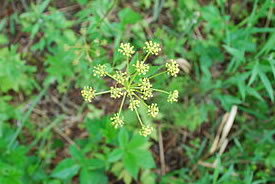
Wild parsnip (Photo by J M, Wikimedia Commons)
Wild parsnip
Wild parsnip is a member of the carrot/parsley family that is recognizable by its yellow-green flowers. The plants grow wild along roadsides and other unmaintained areas, and produce yellow flowers that appear similar in shape to those of Queen Anne’s Lace. This plant is usually found in abandoned fields, meadows, yards, roadsides, railways and trails with moist to dry soils. The plant sap contains chemicals that can cause severe burns to eyes and skin.
How is it identified?
These plants grow up to one-and-a-half metres in height. Their very small, yellow-green flowers in umbrella-shaped clusters bloom from May to September. The leaves are alternately arranged on the stems with mitten-shaped and toothed leaflets.
How does it grow?
Wild parsnip seeds are easily dispersed by wind, water and equipment, such as lawnmowers.
Where does it grow?
In North America, wild parsnip has been reported in all provinces and territories of Canada, except Nunavut. The plant is currently found throughout eastern and southern Ontario, and researchers believe it is spreading from east to west across the province.
What does it threaten?
Wild parsnip spreads rapidly and reduces native vegetation, which reduces biodiversity. Skin contact with its sap can cause severe dermatitis and blistering.
How can you help?
Use extreme caution to avoid skin contact with the plant. Protective equipment, including gloves, coveralls, goggles and face masks should be worn during treatment. For small populations, dig up plants (including roots) when they are still small in the spring. Plant material should be left to dry then left in black garbage bags in the sun for a week or more prior to disposal in a landfill.
Medium-sized populations can be mown and then covered with tarps to prevent regrowth. Chemical control using herbicide in the spring or fall is also an effective tool for licensed pesticide exterminators. To eradicate the population, control treatment will need to repeated over multiple years.
More information >
Everyone can help to win the battle against alien invasive species. Here are some ways you can help:
- Dispose of yard waste properly. Dumping yard waste in natural areas can introduce alien invasive species that will thrive and spread. Even leaf piles can be problematic, as dumped piles can smother native vegetation. Contact your municipality to find out how to dispose of yard waste properly.
- Plant native species in your garden. There are lots of beautiful native species that attract native butterflies and birds, making your garden twice as beautiful. Native species are also adapted to our climate and often require less rigorous care than exotic species.
- Report any sightings to your local stewardship council.
- Clean your shoes or bicycle tires when moving between designated trails in different areas. Invasive plants are often spread accidentally from seeds stuck in treads.



